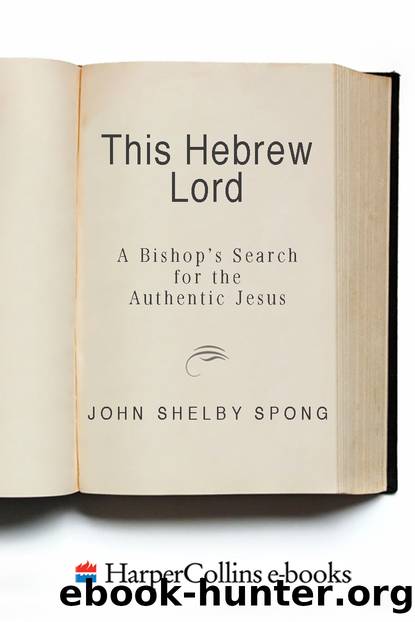This Hebrew Lord by John Shelby Spong

Author:John Shelby Spong
Language: eng
Format: epub
Publisher: HarperCollins
7
THE SUFFERING SERVANTâPART ONE
THE SCRIPTURES FOR Jesus of Nazareth were those of the Hebrew community. These scriptures later became substantially what Christians frequently call the Old Testament. He studied and quoted these sacred writings, and I suspect he looked in them for the interpretation of his own life. What is even more clear is that the early Christian community used the Hebrew scriptures to make sense out of his life. It does seem obvious that Jesus saw himself in some sense as the culmination of the Hebrew messianic expectation. The movement he started was clearly designed to be the new Israel. He conceived his role to be that of inaugurating the kingdom of God. Yet his image of the Messiah, his concept of the new Israel, and his vision of the kingdom of God were quite different from the popular conception of his day. We cannot help but wonder how he came to his understanding.
At this point scholars always reach an impasse, for there are no primary sources. Jesus left no autobiography, no letters, no papers. There was only the impact of his life, interpreted by those who spoke of him and wrote of him. It is impossible to separate completely what Jesus thought of himself from the categories through which he was interpreted. Yet having said this, I am personally convinced that no worshiping church or gospel recorder could have redesigned the whole lifestyle of Jesus solely to suit their interpretive purposes; and therefore, I feel very comfortable going behind their words to search for Jesusâ own understanding.
In this process one image emerges in sharp relief. It is different from the clearly secondary and apologetic images of the new Moses or the new Elijah. This image seems to be deliberately self-imposed, deliberately acted out. It is drawn from the deep and rich Hebrew tradition, but from a part of the tradition that never achieved dominance in Israel. It was the favorite image of some of the smaller splinter groups like the Essenes, as the Dead Sea Scrolls have revealed. This image was primarily the creation of a prophet of the exile whose writings were attached to the back of the scroll of the prophet Isaiah; hence, this writer is called The Second Isaiah.1 The image is known as the suffering servant of the Lord. Let me briefly set the historic context for this profound piece of literature.
As we noted earlier, Davidâs kingdom, which brought the people of Israel together effectively for the first time, did not survive beyond the death of his son, Solomon. It became instead two small, jealous, and warring nations. The kingdom to the north, Israel, was made up of ten tribes, with its capital at Samaria; and the kingdom to the south, Judah, was made up of two tribes, with its capital at Jerusalem.
From the very beginning, the northern kingdom was the least stable. It had no unifying symbol like the Temple of Solomon. It had no established royal family like the House of David. It had no emotional city like the city of Jerusalem.
Download
This site does not store any files on its server. We only index and link to content provided by other sites. Please contact the content providers to delete copyright contents if any and email us, we'll remove relevant links or contents immediately.
It's Never Too Late by Kathie Lee Gifford(599)
The 9.9 Percent by Matthew Stewart(558)
Hebrews, James by George H. Guthrie & George H. Guthrie(551)
Take Back Your Time by Christy Wright(549)
Israel: Ancient Kingdom or Late Invention? by Daniel I. Block(532)
The New Oxford Annotated Bible with Apocrypha by unknow(522)
Eating the Bible by Rena Rossner(513)
The Book Every Leader Needs to Read by 48 Authors(507)
Insights on Hebrews by Charles R. Swindoll(506)
Psalms, Proverbs, Ecclesiastes, and Song of Songs by John W. Hilber & Tremper Longman III & Duane Garrett(492)
The Jew in the Lotus by Rodger Kamenetz(445)
Commentary on the Torah by Richard Elliott Friedman(442)
Who Wrote the Bible? by Richard Elliott Friedman(441)
Judges: Volume Two by unknow(440)
Commentary on James (Commentary on the New Testament Book #16) by Robert H. Gundry(415)
NKJV, Ignite, eBook by Thomas Nelson(411)
Proverbs, Ecclesiastes, Song of Solomon (Ancient Christian Commentary on Scripture) by J. Robert Wright(406)
Job, Ecclesiastes, Song of Songs by August H. Konkel & Tremper Longman III(405)
Reading the Bible with Rabbi Jesus by Tverberg Lois(385)
